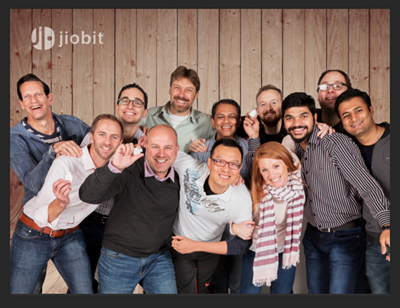AWS News Blog
AWS Hot Startups – February 2017
|
|
September 8, 2021: Amazon Elasticsearch Service has been renamed to Amazon OpenSearch Service. See details.
As we finish up the month of February, Tina Barr is back with some awesome startups.
-Ana
This month we are bringing you five innovative hot startups:
- GumGum – Creating and popularizing the field of in-image advertising.
- Jiobit – Smart tags to help parents keep track of kids.
- Parsec – Offers flexibility in hardware and location for PC gamers.
- Peloton – Revolutionizing indoor cycling and fitness classes at home.
- Tendril – Reducing energy consumption for homeowners.
If you missed any of our January startups, make sure to check them out here.
GumGum (Santa Monica, CA)
 GumGum is best known for inventing and popularizing the field of in-image advertising. Founded in 2008 by Ophir Tanz, the company is on a mission to unlock the value held within the vast content produced daily via social media, editorials, and broadcasts in a variety of industries. GumGum powers campaigns across more than 2,000 premium publishers, which are seen by over 400 million users.
GumGum is best known for inventing and popularizing the field of in-image advertising. Founded in 2008 by Ophir Tanz, the company is on a mission to unlock the value held within the vast content produced daily via social media, editorials, and broadcasts in a variety of industries. GumGum powers campaigns across more than 2,000 premium publishers, which are seen by over 400 million users.
In-image advertising was pioneered by GumGum and has given companies a platform to deliver highly visible ads to a place where the consumer’s attention is already focused. Using image recognition technology, GumGum delivers targeted placements as contextual overlays on related pictures, as banners that fit on all screen sizes, or as In-Feed placements that blend seamlessly into the surrounding content. Using Visual Intelligence, GumGum can scour social media and broadcast TV for all images and videos related to a brand, allowing companies to gain a stronger understanding of their audience and how they are relating to that brand on social media.
GumGum relies on AWS for its Image Processing and Ad Serving operations. Using AWS infrastructure, GumGum currently processes 13 million requests per minute across the globe and generates 30 TB of new data every day. The company uses a suite of services including but not limited to Amazon EC2, Amazon S3, Amazon Kinesis, Amazon EMR, AWS Data Pipeline, and Amazon SNS. AWS edge locations allow GumGum to serve its customers in the US, Europe, Australia, and Japan and the company has plans to expand its infrastructure to Australia and APAC regions in the future.
For a look inside GumGum’s startup culture, check out their first Hackathon!
Jiobit (Chicago, IL)
 Jiobit was inspired by a real event that took place in a crowded Chicago park. A couple of summers ago, John Renaldi experienced every parent’s worst nightmare – he lost track of his then 6-year-old son in a public park for almost 30 minutes. John knew he wasn’t the only parent with this problem. After months of research, he determined that over 50% of parents have had a similar experience and an even greater percentage are actively looking for a way to prevent it.
Jiobit was inspired by a real event that took place in a crowded Chicago park. A couple of summers ago, John Renaldi experienced every parent’s worst nightmare – he lost track of his then 6-year-old son in a public park for almost 30 minutes. John knew he wasn’t the only parent with this problem. After months of research, he determined that over 50% of parents have had a similar experience and an even greater percentage are actively looking for a way to prevent it.
Jiobit is the world’s smallest and longest lasting smart tag that helps parents keep track of their kids in every location – indoors and outdoors. The small device is kid-proof: lightweight, durable, and waterproof. It acts as a virtual “safety harness” as it uses a combination of Bluetooth, Wi-Fi, Multiple Cellular Networks, GPS, and sensors to provide accurate locations in real-time. Jiobit can automatically learn routes and locations, and will send parents an alert if their child does not arrive at their destination on time. The talented team of experienced engineers, designers, marketers, and parents has over 150 patents and has shipped dozens of hardware and software products worldwide.
The Jiobit team is utilizing a number of AWS services in the development of their product. Security is critical to the overall product experience, and they are over-engineering security on both the hardware and software side with the help of AWS. Jiobit is also working towards being the first child monitoring device that will have implemented an Alexa Skill via the Amazon Echo device (see here for a demo!). The devices use AWS IoT to send and receive data from the Jio Cloud over the MQTT protocol. Once data is received, they use AWS Lambda to parse the received data and take appropriate actions, including storing relevant data using Amazon DynamoDB, and sending location data to Amazon Machine Learning processing jobs.
Visit the Jiobit blog for more information.
Parsec (New York, NY)
 Parsec operates under the notion that everyone should have access to the best computing in the world because access to technology creates endless opportunities. Founded in 2016 by Benjy Boxer and Chris Dickson, Parsec aims to eliminate the burden of hardware upgrades that users frequently experience by building the technology to make a computer in the cloud available anywhere, at any time. Today, they are using their technology to enable greater flexibility in the hardware and location that PC gamers choose to play their favorite games on. Check out this interview with Benjy and our Startups team for a look at how Parsec works.
Parsec operates under the notion that everyone should have access to the best computing in the world because access to technology creates endless opportunities. Founded in 2016 by Benjy Boxer and Chris Dickson, Parsec aims to eliminate the burden of hardware upgrades that users frequently experience by building the technology to make a computer in the cloud available anywhere, at any time. Today, they are using their technology to enable greater flexibility in the hardware and location that PC gamers choose to play their favorite games on. Check out this interview with Benjy and our Startups team for a look at how Parsec works.
Parsec built their first product to improve the gaming experience; gamers no longer have to purchase consoles or expensive PCs to access the entertainment they love. Their low latency video streaming and networking technologies allow gamers to remotely access their gaming rig and play on any Windows, Mac, Android, or Raspberry Pi device. With the global reach of AWS, Parsec is able to deliver cloud gaming to the median user in the US and Europe with less than 30 milliseconds of network latency.
Parsec users currently have two options available to start gaming with cloud resources. They can either set up their own machines with the Parsec AMI in their region or rely on Parsec to manage everything for a seamless experience. In either case, Parsec uses the g2.2xlarge EC2 instance type. Parsec is using Amazon Elastic Block Storage to store games, Amazon DynamoDB for scalability, and Amazon EC2 for its web servers and various APIs. They also deal with a high volume of logs and take advantage of the Amazon Elasticsearch Service to analyze the data.
Be sure to check out Parsec’s blog to keep up with the latest news.
Peloton (New York, NY)
 The idea for Peloton was born in 2012 when John Foley, Founder and CEO, and his wife Jill started realizing the challenge of balancing work, raising young children, and keeping up with personal fitness. This is a common challenge people face – they want to work out, but there are a lot of obstacles that stand in their way. Peloton offers a solution that enables people to join indoor cycling and fitness classes anywhere, anytime.
The idea for Peloton was born in 2012 when John Foley, Founder and CEO, and his wife Jill started realizing the challenge of balancing work, raising young children, and keeping up with personal fitness. This is a common challenge people face – they want to work out, but there are a lot of obstacles that stand in their way. Peloton offers a solution that enables people to join indoor cycling and fitness classes anywhere, anytime.
Peloton has created a cutting-edge indoor bike that streams up to 14 hours of live classes daily and has over 4,000 on-demand classes. Users can access live classes from world-class instructors from the convenience of their home or gym. The bike tracks progress with in-depth ride metrics and allows people to compete in real-time with other users who have taken a specific ride. The live classes even feature top DJs that play current playlists to keep users motivated.
With an aggressive marketing campaign, which has included high-visibility TV advertising, Peloton made the decision to run its entire platform in the cloud. Most recently, they ran an ad during an NFL playoff game and their rate of requests per minute to their site increased from ~2k/min to ~32.2k/min within 60 seconds. As they continue to grow and diversify, they are utilizing services such as Amazon S3 for thousands of hours of archived on-demand video content, Amazon Redshift for data warehousing, and Application Load Balancer for intelligent request routing.
Tendril (Boulder, CO)
 Tendril was founded in 2004 with the goal of helping homeowners better manage and reduce their energy consumption. Today, electric and gas utilities use Tendril’s data analytics platform on more than 140 million homes to deliver a personalized energy experience for consumers around the world. Using the latest technology in decision science and analytics, Tendril can gain access to real-time, ever evolving data about energy consumers and their homes so they can improve customer acquisition, increase engagement, and orchestrate home energy experiences. In turn, Tendril helps its customers unlock the true value of energy interactions.
Tendril was founded in 2004 with the goal of helping homeowners better manage and reduce their energy consumption. Today, electric and gas utilities use Tendril’s data analytics platform on more than 140 million homes to deliver a personalized energy experience for consumers around the world. Using the latest technology in decision science and analytics, Tendril can gain access to real-time, ever evolving data about energy consumers and their homes so they can improve customer acquisition, increase engagement, and orchestrate home energy experiences. In turn, Tendril helps its customers unlock the true value of energy interactions.
AWS helps Tendril run its services globally, while scaling capacity up and down as needed, and in real-time. This has been especially important in support of Tendril’s newest solution, Orchestrated Energy, a continuous demand management platform that calculates a home’s thermal mass, predicts consumer behavior, and integrates with smart thermostats and other connected home devices. This solution allows millions of consumers to create a personalized energy plan for their home based on their individual needs.
Tendril builds and maintains most of its infrastructure services with open sources tools running on Amazon EC2 instances, while also making use of AWS services such as Elastic Load Balancing, Amazon API Gateway, Amazon CloudFront, Amazon Route 53, Amazon Simple Queue Service, and Amazon RDS for PostgreSQL.
Visit the Tendril Blog for more information!
— Tina Barr
